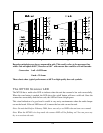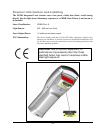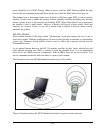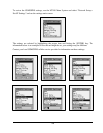
14
The M7100 Internal Radio
The M7100 Handheld Terminal comes equipped with an internal 802.11b radio and antenna. This
internal radio is specifically designed to communicate with any 802.11b Access Point. The range
of the internal radio depends greatly on the quality of the Access Point and the RF
communications characteristic of the environment where the device is used. The typical range for
an 802.11b radio is 500 feet through free air. Additional Access Points must be added to improve
coverage in a larger area, or in electrically noisy RF environments.
802.11b Fallback Mode
Wireless LAN technology is designed to make maintaining a connection between two devices as
reliable and consistent as possible. Since the speed of the connection between wireless devices
will vary as range and signal quality varies, the wireless devices will intentionally sacrifice
throughput (data rate or connection speed as measured in bits per second) in exchange for
maintaining a reliable connection. In other words, a reliable connection at a lower speed is
preferred over an unreliable connection at a higher speed (i.e., it is easier to maintain the
connection if data rate is deliberately reduced, or put another way, lower data rates will tolerate a
higher range and/or worse signal quality). This characteristic is known as fallback. As example, an
802.11b system will fallback from 11 Mbps to 5.5 Mbps as range increases or signal quality
decreases. Subsequent fallbacks from 5.5 Mbps to 2 Mbps and 1 Mbps are also supported
Interference and Coexistence
802.11b operates in a range of radio frequencies known as an "unlicensed" band (i.e. the FCC does
NOT require the use of a license in order to operate a radio transmitter in this range). This means
that commercially available radio devices other than wireless LAN devices are permitted to use
the same frequency band as 802.11b. Consequently, these co-existing radio devices can interfere
or "jam" the wireless LAN (and vice versa). Ironically, the most troublesome devices are cordless
telephones and microwave ovens.
Fortunately, higher quality cordless phones tend to "listen" for a clear channel before becoming
active and will thus avoid interfering with a wireless LAN (i.e., the cordless phone seeks a clear
channel for itself so naturally avoids being interfered with or being a source of interference).
Jamming from microwave ovens is more severe but is usually restricted to the upper frequency
range for 802.11b (it should be noted that 802.11b divides the available frequency band into 11
channels. The higher numbered channels are most susceptible to microwave oven interference).
In each instance, jamming occurs only when the cordless telephone or microwave oven is active.
Security Issues
Much has been publicized in the media about security problems with wireless LANs. Although it
cannot be denied that the encryption algorithms currently used in 802.11b are flawed, the fact is
that security breaches of a wireless LAN require a deliberate attempt to access the network by an
intruder. It is highly recommended that WEP encryption be used and in some cases the access


















